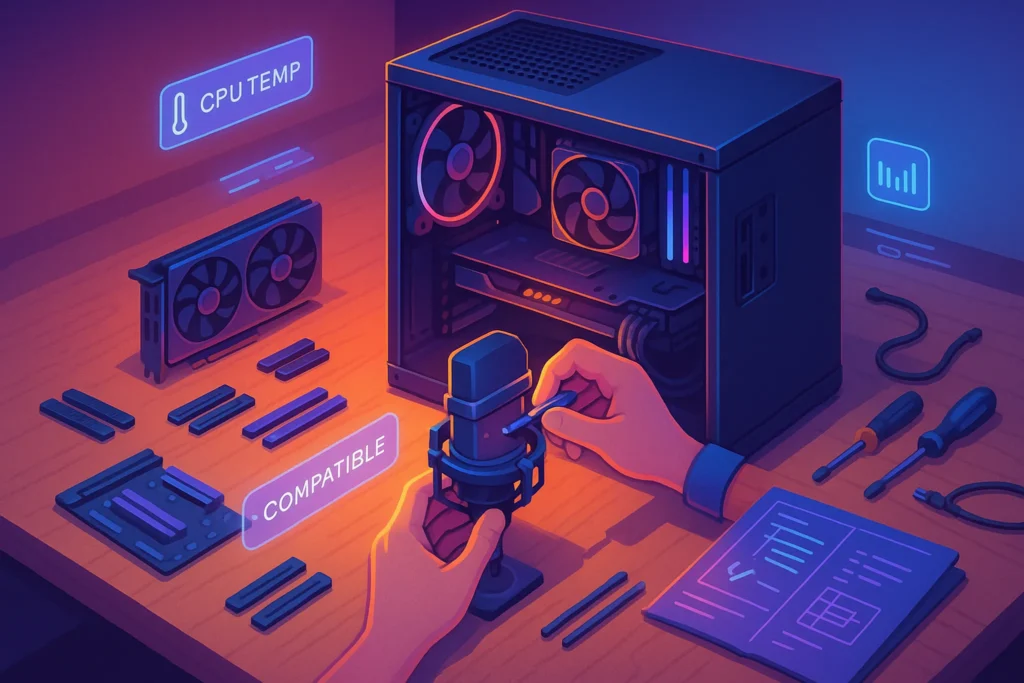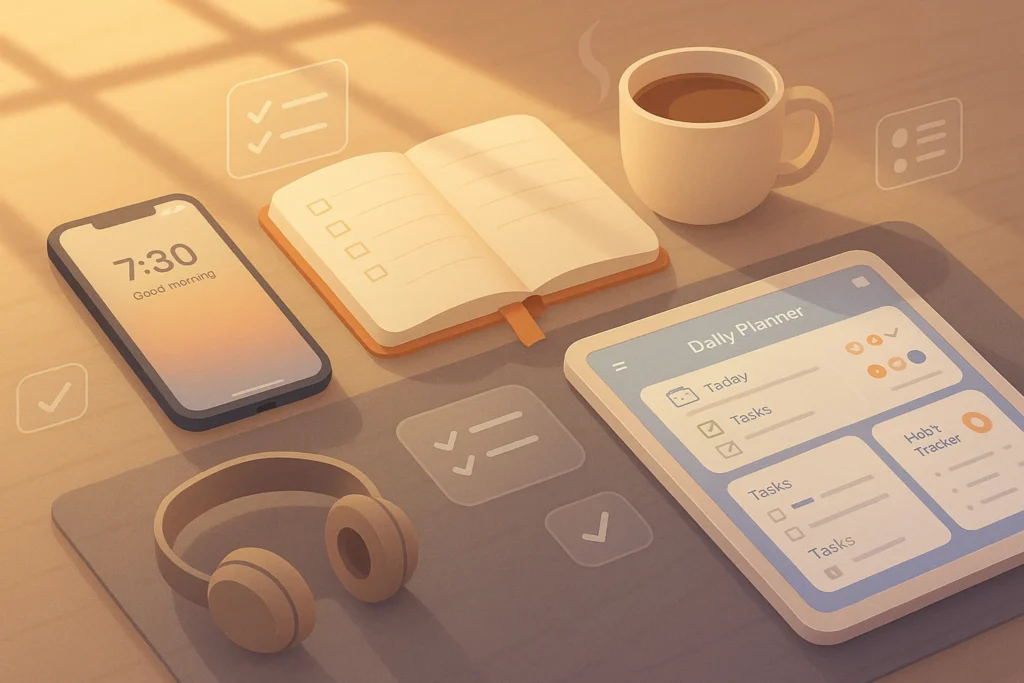🔧 Introduction: Why Build a PC Yourself?
Building your own PC can feel intimidating at first — but with the right planning and guidance, it’s not only doable, it’s incredibly rewarding. Whether you’re aiming for a gaming powerhouse, a productivity rig, or a budget-friendly desktop, understanding how each component fits together gives you control, upgrade flexibility, and better performance per dollar.
In this guide, we’ll walk you through the full process — from choosing parts to powering on — with pro tips to help first-timers avoid frustration and build like seasoned PC enthusiasts.
🧩 Planning Your Build
Before you buy anything, ask:
“What am I building this PC for?”
-
Gaming: Focus on a powerful GPU, at least 16GB RAM, and a CPU like Ryzen 5 or Intel i5+
-
Video Editing or 3D Work: Prioritize multi-core CPUs (Ryzen 9, Intel i7+), large RAM, and NVMe storage
-
Office & Light Use: Entry-level CPU (i3 or Ryzen 3), 8GB RAM, integrated graphics are usually enough
Once your use case is clear, you’ll need to ensure component compatibility:
✅ CPU + Motherboard: Match socket types (e.g., AM5 for Ryzen 7000, LGA 1700 for Intel 13th gen)
✅ RAM: Check type (DDR4 vs DDR5), supported speed, and max capacity for your motherboard
✅ Power Supply (PSU): Must provide enough wattage (with headroom) and correct connectors
✅ Case size: Confirm GPU/CPU cooler clearance and motherboard form factor (ATX, mATX, ITX)
Tools like PCPartPicker can help you check compatibility automatically before you buy.
Also consider airflow, aesthetics (RGB?), and upgrade paths.
🛠️ Assembly Essentials: Step-by-Step Hardware Installation
Once you’ve unboxed your components, it’s time to assemble your machine. Don’t rush — take it one step at a time and stay grounded to avoid static damage.
Here’s a Step-by-Step walkthrough:
🧩 Install CPU onto Motherboard
This is the brain of your PC — handle with care!
-
Open the CPU socket on your motherboard.
-
For Intel, lift the metal lever and flip up the bracket.
-
For AMD, lift the small plastic lever to open the socket.
-
-
Match the golden triangle on the CPU with the triangle on the socket.
This ensures proper alignment — never force it. -
Gently place the CPU into the socket.
-
Don’t press down hard — it should drop in easily if aligned correctly.
-
-
Lower the bracket and lock it in place.
-
Intel might make a little “creak” when you press the lever down — that’s normal.
-
⚠️ Don’t touch the pins on the underside of the CPU. Oils from your skin can cause serious issues.
❄️ Apply Thermal Paste & Mount CPU Cooler
Skip this step if your cooler has pre-applied thermal paste (many do!).
-
Put a pea-sized dot of thermal paste in the center of the CPU.
-
That’s all you need — don’t smear or overdo it.
-
-
Position the cooler over the CPU and lower it evenly.
-
Some coolers screw in, others clip — check your model’s manual.
-
-
Secure the cooler.
-
If it uses screws, tighten them diagonally (like tightening a car tire).
-
Plug the cooler’s cable into the CPU_FAN header on the motherboard.
-
⚠️ Forgetting the fan cable = CPU will overheat. Always double-check the connection.
🧠 Insert RAM Sticks
-
Check your motherboard manual to see which slots to use.
-
Usually, you skip the first slot and use slots 2 and 4 for dual-channel setup.
-
-
Open the side clips on the RAM slots.
-
Some motherboards only have one movable clip per slot — that’s fine.
-
-
Align the notch on the RAM stick with the ridge in the slot.
-
It only fits one way. Don’t flip it by force.
-
-
Push down firmly until both clips snap into place.
-
You should hear or feel a “click.”
-
⚠️ If the RAM isn’t clicked in fully, your PC won’t boot. Double-check before moving on.
💾 Install M.2 SSD (If Applicable)
-
Find the M.2 slot on your motherboard.
-
It looks like a skinny horizontal slot with a tiny screw nearby.
-
-
Slide the SSD into the slot at a slight angle (about 30°).
-
It should gently slide in without pressure.
-
-
Press the SSD flat and secure it with the tiny screw.
-
This keeps it from wiggling out or disconnecting.
-
⚠️ Don’t lose the screw! It’s specific to M.2 drives and easy to misplace.
🖥️ Place Motherboard Into Case
-
Snap the I/O Shield into the back of the case.
-
This is the metal plate that covers your ports. Press firmly until it clicks.
-
-
Carefully lower the motherboard into the case.
-
Line up the ports with the I/O shield, and align the holes with the standoffs.
-
-
Secure the motherboard with screws.
-
Usually 6–9 screws. Use a normal screwdriver and don’t overtighten.
-
⚠️ If there are no standoffs under the board, stop! Installing without them can cause a short.
🔌 Mount PSU and Connect Power Cables
-
Insert the power supply into the PSU compartment.
-
The fan should face out or down, depending on your case airflow.
-
-
Secure the PSU using 4 screws.
-
They go on the back of the case where the power plug is.
-
-
Plug in the main power cables:
-
24-pin cable to motherboard (largest connector).
-
8-pin CPU cable to top of motherboard.
-
SATA power cables to SSDs/HDDs.
-
PCIe power cables for graphics card (later).
-
⚠️ Forgetting the CPU cable is a common beginner mistake — your PC won’t power on.
🎮 Install GPU (Graphics Card)
-
Remove the PCIe slot covers from your case.
-
Most GPUs take up 2 slots, so remove 2 horizontal brackets near the back.
-
-
Align the GPU with the top PCIe slot and push it in firmly.
-
You should hear a “click” when it locks in.
-
-
Screw the GPU bracket to the case to hold it in place.
-
Use the same screws that held the slot covers.
-
-
Connect PCIe power cables (usually 6 or 8-pin) from PSU to the GPU.
⚠️ No display? Check that the card is fully seated and plugged into the PSU.
A tidy build not only helps your system run better — it also saves you time during future upgrades or troubleshooting. If you’re planning to install Wi-Fi cards, extra SSDs, or a new GPU later, good cable management and spacing make a big difference. (Check out our guide on DIY Tech Troubleshooting to see how organized layouts simplify diagnostics.)
🔌 Connect Front Panel Headers
This is the fiddly part — small wires that control your power/reset buttons and LEDs.
-
Check your motherboard manual for the pin layout.
-
Look for “Front Panel Header” or “F_PANEL” in the diagram.
-
-
Connect these small cables carefully:
-
Power SW – turns your PC on
-
Reset SW – resets your system (optional)
-
HDD LED – hard drive activity light
-
Power LED – shows when PC is on
-
-
Also connect case USB ports, audio jacks, and USB-C (if available).
-
These are bigger cables and easier to spot.
-
⚠️ Backward polarity can stop LEDs from working. Double-check the + and – markings.
Nerd Tip: Build outside the case first (on a box or test bench) if you want to boot test the motherboard before full installation.
🧹 Cable Management Like a Pro
A clean build is not only satisfying — it improves airflow, troubleshooting, and aesthetics.
-
Route cables behind the motherboard tray
-
Use Velcro straps or zip ties to bundle cables neatly
-
Feed SATA and fan cables through grommets or designated holes
-
Avoid crossing GPU power cables over airflow zones
Modern cases often include cable channels and PSU shrouds to simplify the process. Take your time — the payoff is worth it.
📬 Want More Build Guides Like This?
Join our free newsletter to get weekly tips on DIY tech builds, gear reviews, and smart upgrade strategies — straight to your inbox.
🔐 100% privacy. No spam. Just expert content from NerdChips.
⚙️ BIOS Setup & First Boot
After your build is assembled, it’s moment-of-truth time. Here’s what to expect:
-
Power on and enter BIOS (usually Del or F2 key)
-
Check system info: CPU, RAM, drives detected?
-
Set boot order to prioritize your OS installation drive (USB or DVD)
-
Enable XMP/DOCP profile for RAM to run at intended speed
-
Check CPU and fan temps — make sure cooling is functioning properly
If everything looks good, proceed with OS installation. For most users, that’s Windows 10/11 via bootable USB. Tools like Rufus make it easy to create one.
📋 Optional: Save your BIOS settings and take a picture of your cable management — it’ll help later if you upgrade or troubleshoot.
And for maximizing battery efficiency on your devices, don’t miss our power-saving guide: Pro Tips for Maximizing Your Smartphone’s Battery Life.
📥 Free Printable Checklist: Build Your PC Without Missing a Step
Get our printable, beginner-friendly PC Build Checklist (PDF) — perfect to follow along as you assemble your first computer. Includes power checks, component tips, and troubleshooting reminders.
No more missed steps.
Enter your email to instantly receive the PDF File:
📩 We respect your inbox. Zero spam — just helpful guides from NerdChips.
© NerdChips.com
🧠 Avoiding Common First-Timer Mistakes
Even seasoned builders make mistakes — but here are a few traps you can avoid from day one:
-
❌ Forgetting motherboard standoffs – can short the board
-
❌ Forcing parts in wrong orientation – check alignment before pushing
-
❌ Skipping PSU research – always choose a certified (80+ Bronze or better) PSU from trusted brands
-
❌ Cable chaos – messy cables block airflow, trap heat
-
❌ Neglecting case airflow – intake fans (front/bottom) + exhaust (rear/top) = good thermal balance
Remember: Patience, research, and precision are your best friends when building your first rig.
🛠️ Ready to Build Your Dream PC?
Check out our curated list of top-rated PC components — motherboards, SSDs, RAM kits, PSUs, and more — perfect for first-time builders. We’ve handpicked them for reliability, compatibility, and budget flexibility.
Affiliate Disclosure: We may earn a small commission from purchases made through links — at no extra cost to you.
🧰 Recommended Beginner-Friendly Toolkits
Before diving into your build, having the right tools can make the entire process smoother and safer — especially if you’re just starting out.
Here’s what we recommend for first-timers:
-
Magnetic Screwdriver Kit: Prevents losing screws inside the case. Brands like iFixit or Jakemy are great starter kits.
-
Anti-Static Wrist Strap: Ground yourself to prevent damaging sensitive components with static electricity.
-
Plastic Tweezers or Spudgers: Helpful for plugging in tiny front panel headers or removing stubborn cables.
-
Magnetic Parts Tray: Keeps your screws and accessories from disappearing off the desk.
💡 Pro Tip: Avoid working on carpet. Use a wooden desk or a grounded surface to build safely.
🧪 Test Before Closing the Case (Outside-the-Case Boot)
One of the smartest things you can do — especially as a beginner — is to test your core components outside the case before full assembly.
This is called an open-air POST test and saves you headaches if a part is faulty.
-
Place the motherboard on the cardboard box it came in.
-
Install the CPU, cooler, one stick of RAM, and plug in the PSU.
-
Connect the GPU (if your CPU has no integrated graphics).
-
Power it on using the motherboard’s Power Switch pins (you can short them with a screwdriver).
If you hear a beep, see fans spinning, or get a display on your monitor — you’re good to go for full installation.
🔧 If nothing happens, it’s easier to troubleshoot now before everything is inside the case.
🎯 Where to Buy Parts Safely (With Affiliate-Friendly Suggestions)
Many beginners are unsure where to shop. Here’s a short guide to trusted places for buying PC parts:
-
Amazon – Widely trusted and easy returns, perfect for SSDs, RAM, and beginner kits.
-
Newegg – Ideal for U.S. buyers, with specific PC-builder deals and DIY bundles.
-
AliExpress – Good for budget-friendly accessories, fans, or toolkits. Shipping takes longer.
-
B&H Photo Video – Especially useful for professional-grade components and international shipping.
🚫 Avoid unknown eBay sellers or local marketplaces unless they offer verified warranties.
If you’re planning to code, edit videos, or work remotely from your new machine, pair it with smart accessories from our Upgrade Your Home Office list.
🧠 Nerd Verdict
For beginners, building a PC is one of the most empowering tech experiences. It teaches not just hardware knowledge, but confidence, patience, and problem-solving. While it may feel technical at first, modern cases, modular PSUs, and online resources have made it easier than ever.
So if you’ve been holding back, let this be your sign: You can do this.
Your dream rig is just a few screws away.
❓ FAQ: Nerds Ask, We Answer
💬 Would You Bite?
What’s stopping you from building your first PC?
Drop a comment below — fear of breaking things, budget, compatibility confusion? Let’s troubleshoot your doubts together 🧠💬



